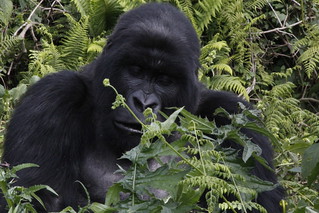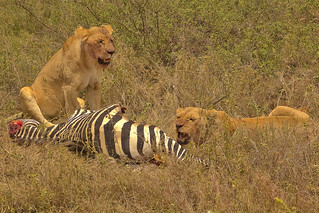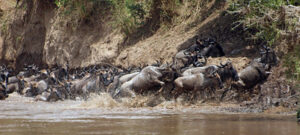Serengeti National Park is one of Africa’s most famous parks with the largest concentration of game that offers sights of the migration of millions of wildebeest. Serengeti National Park is the second largest park in Tanzania after Nyerere national park with an approximate coverage of 14,750 square kilometers. The name Serengeti originates from the Maasai language meaning endless plains which currently describes its status.
This park is greatly endowed with remarkable landscapes and diverse ecosystems composed of an extra-wide coverage of savanna grasslands and woodlands. This serene park is divided into four sections that is the northern, central, southern, and eastern sections. The sections are visited seasonally based on the flow of the migration.
In the central part of the park lies the popular Seronera area that attracts many tourists because of its numerous wildlife species, especially the big cats, and is often referred to as the “big cat capital”. The Seronera Valley is characterized by savanna plains dotted with acacia trees and some of the cats in the area include lions, leopards, and cheetahs.
Activities carried out in the Seronera area of Serengeti National Park
Game drives at Seronera
This is the most enjoyed activity in the Seronera area. The rich wildlife diversity and a high concentration of predators make a visit to this area very fruitful. Game drives in the vast savanna plains in the Seronera area expose you to sights of various wildlife species like zebras, wildebeests, elephants, giraffes, elands, waterbucks, antelopes, and many others in addition to precious bird species.
Game drives in the Seronera area are carried out in different series of the day, in the morning, afternoon, or evening. Full-day game drives are also carried out. At times night game drives are done in selected places but with permission and guidance of game guides. In this activity, many animals can be spotted in the savanna grasslands especially the predators trying to spot their prey. Along the game drives, enjoy the more animals grazing and the breathtaking nature of the landscape.
Tourists on a game drive are advised to remain on track and avoid making noise as the noise scares away the animals and avoid eating while moving in the park as it disrupts the feeding attention of the animals.
Viewing the great migration
The great wildebeest migration is witnessed at different times of the year in the different sections of Serengeti National Park. During this striking event, thousands of wildebeests, zebras, and gazelles move around the park. the Seronera area is best for this activity from April to June during the first rainy season of the year. At the end of the season is the mating season of the wildebeest
Bird Watching at seronera
This is an all-year-round activity in the Seronera area of Serengeti National Park. this park is home to over 500 bird species and the best spot for birding in the Seronera area is the Seronera River Valley. The most recommended times for this activity are the months of November and April. Some of the bird species in the area include eagles, vultures, hornbills, starlings, woodpeckers, weavers yellow-throated sand grouse, and many others.
Hot air balloon safaris in Seronera
The hot air balloon experience is a unique and awesome activity carried out in the Seronera area. This activity provides a breathtaking perspective of exploring all of Serengeti National Park in an aerial view. Participants in this activity fly to the skies in a ball0on and view all the park corners from above like birds. Animals, birds, rivers, and vegetation are clearly noticed. This activity is usually carried out early morning before the sun rises and on landing, the activity includes hot coffee and a champagne breakfast in the park bushes.
Cultural Visits
In the outskirts of Serengeti National Park, are the Maasai people. Tourists to the Seronera area should not miss out on visiting these people with unique culture and tradition. The Maasai exhibit beautiful craftwork of beaded necklaces, earrings, belts, and shukas. These people have lived a nomadic life for centuries and are so interactive and welcoming.
Visiting the Seronera River, Seronera Valley, and the Hippo pool area
One of the places that can’t be missed out on a safari to the Seronera area is the Seronera Valley. This place is a major hideout for big cats like lions, cheetahs, and leopards. Lions and leopards are usually spotted on the rocks that stand far from the surroundings. More cats in the area include serval cats, hyenas, jackals, and caracals.
The Seronera River lies in the Seronera Valley and is a prominent source of water for animals in the area. The Hippo pool area close to the river is the best spot for sighting hippos as they cool their bodies and interact with each other.
Photography
Since the area is too scenic with both wildlife and vegetation, it provides the best time for photographers. Animals are so abundant, and photo shots can be taken from both far and close range by both non-professionals and specialists.
Best time to visit the Seronera area in Serengeti National Park
Visits to the Seronera area are done throughout the year though the most favorable s time is from April to June. Many animals are spotted in the vast savanna grasslands and along the Seronera River. However, the months of November and March have short downpours that can’t hinder any of the activities in the area. The heavy rains from March to May are so conducive for bird-watching activities as flocks of migratory birds fly to the park from Europe.
How to get to the Seronera area
The means of transport you choose when planning your trip to Seronera depends on your budget and travel time. There are optional means by which you get to this place, and these are: by air, road, or combining the two.
You can use multiple flights from within Tanzania to Seronera airstrip, from Arusha, Zanzibar, and Dar es Salaam. Flights are so fast that on landing you can transfer to your hotel then move to the park for a game drive.
When you use the road, transfer from Arusha in a 4×4 vehicle on a voyage that takes 6-7 hours which is approximately 325 kilometers. This means takes more hours but exposes you to scenic views of Lake Manyara National Park and the Ngorongoro crater.
Alternatively, you may decide to combine the two means of transport on your safari by arriving in Seronera from Arusha on a flight and traveling by road back to Seronera on the last day of your safari.
Using these means of transport, you will safely arrive in the Seronera area and enjoy the natural wonders of Serengeti National Park
Popular wildebeest safaris in serengeti national park
10 Day Wildebeest and gorillas vacation safaris

Embark on a captivating journey through the heart of East Africa as we invite you to explore the enchanting landscapes, vibrant cultures, and rich biodiversity of Rwanda and Tanzania. This meticulously crafted 10-day itinerary promises an immersive experience, seamlessly blending the awe-inspiring encounters with gorillas
| TRIP DETAILS |
| REQUEST INFO |
6 Day Wildebeest and gorilla trekking safari

Book 6 Days Ngorongoro crater visit and Rwanda gorilla trekking to explore Tanzania & Rwanda on an Africa Safari experience tailored by Active African vacation the leading Safari operator in Uganda. The 6 Days Tanzania Rwanda Safari takes you to the great Ngorongoro crater reserve for an amazing wildlife experience.
| TRIP DETAILS |
| REQUEST INFO |
7 Day Rwanda-Tanzania vacation safari

Depending on the degree of lodging, the time of year, and the particular parks and activities included a 7-day safari in Rwanda and Tanzania might have somewhat different costs. Along with activities to do in every park, below is a sample schedule including expected expenses for middle-class, budget, and luxury alternatives.
| TRIP DETAILS |
| REQUEST INFO |


